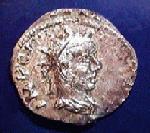Roman Emperors Dir Regalianus
An Online Encyclopedia of Roman Emperors
Regalianus (260 A.D.)
William Leadbetter

Aurelius Victor, in his summary account of the years of Valerian and Gallienus, notes in passing that the survivors of Ingenuus' rebellion were gathered by Regalian, who renewed the revolt in Pannonia. Victor thus brackets the suppression of both revolts together, crediting them to Gallienus.[[1]] Historical reality is likely to be a little more complex. Unlike Ingenuus, Regalian did mint coins, both in his own name and that of his wife Sulpicia Dryantilla, at a hastily established mint at Carnuntum.
The brief biography of Regalian in the Historia Augusta claims that Regalian was a Dacian by birth, and a descendant of Decebalus.[[2]] While such a detail is delectable, it is unlikely to be true. What is probable, however, is that Regalian was of senatorial rank. This detail is implied by his marriage to Sulpicia Dryantilla, a lady of high lineage.[[3]] It is uncertain how far Regalian was involved in the revolt of Ingenuus. Victor's account would seem to indicate that he was deeply implicated and, in a sense, continued it. This perspective has been rejected by most recent scholars who perceive a hiatus between the two revolts.
What is clear is that, if the spurious certainties of the HA are set aside, then very little was known about Regalian within the literary tradition. The major narrative sources (themselves only summaries) cannot even get Regalian's name right: Eutropius calls him Trebellianus; Aurelius Victor and the Epitome both call him Regillianus.[[4]] The coinage discloses a little more detail, although even here, Regalian's full name cannot be clearly discerned, and so he remains P. C. Regalianus. Three facts about the coins do, however, assist. Firstly, they are all overstruck issues. Regalian's mint used coins of earlier third-century-emperors (including Septimius Severus, Severus Alexander and Maximinus).[[5]] Secondly, they all derive from a mint at Carnuntum ; thirdly, the find-spots of these coins are largely concentrated around Carnuntum and Vindobona on the Upper Danube.[[6]] These facts make it clear that the urban centre of Regalian's revolt was Carnuntum itself, and that the revolt cannot have had either broad geographical compass or long duration.
Moreover, the location of Carnuntum, a garrison town on the Upper Danube, makes it most probable that the revolt of Regalian responded to a local threat to security rather than dynastic pique. 260 was a year both of calamity in the east, and of multiple threats to imperial security in Europe. Ingenuus' revolt had offered some hope in Pannonia of a strong local imperial presence. His failure and death, followed by Gallienus' swift departure to deal with an Alemannic invasion of Italy, left a power vacuum in the Danubian provinces at a critical time. It was this which Regalian moved to fill so as to provide strong local leadership against immediate threats from across the Danube. In order to bolster his position, his wife was raised to the rank of Augusta, and coins were struck at Carnuntum to mark and promote this partnership.[[7]]
The Historia Augusta notes that Regalian was not defeated by Gallienus, but by a combination of his own people and the Roxolani, after he had bravely contended with the Sarmatians[[8]]. This account has been substantially accepted by Fitz and others.[[9]] It seems to be a likely reconstruction of events. Fitz is right to point to the considerable devastation which Pannonian cities suffered at this time. It is in this destruction that both the inspiration of the revolt of Regalian lies, and also its more obscure end. Whether deliberately or unwittingly, Regalian had performed a valuable service for Gallienus in providing a focus of opposition to the invading tribes in 260. It bought Gallienus valuable time to deal with the more immediate threat of an Alemannic invasion of Italy. Nevertheless, it did not endear Gallienus to the locals, who (correctly) perceived him to be putting their security aside in order to concentrate upon the safety of Italy. In the following year, when another pair of usurpers (the Macriani) arrived from the east, they found many in the Pannonian provinces eager to help another endeavour to overthrow Gallienus.[[10]]
BIBLIOGRAPHY
Andreas Alföldi (1929) "The Numbering of the Victories of the Emperor Gallienus and the Loyalty of his Legions", Numismatic Chronicle, 9 (ser.5), 218 - 279.
John Bray (1997) Gallienus: a study in reformist and sexual politics, Adelaide.
Lukas de Blois (1976) The Policy of the Emperor Gallienus, Leiden.
E. Demougeot (1969) La formation de l'Europe. Les invasions barbares des origines germaniques à l'avènement de Dioclétien, Paris.
John Drinkwater (1987) The Gallic Empire: separatism and continuity in the north-western provinces of the Roman Empire A.D. 260 - 274, Historia Einzelschriften 52.
Jeno Fitz (1966) Ingenuus et Régalien, Coll. Lat. 81.
________. (1976) La Pannonie sous Gallien, Coll. Lat. 148.
David S. Potter (1990) Prophecy and History in the Crisis of the Roman Empire, A Historical Commentary on the Thirteenth Sibylline Oracle, Oxford.
Sir Ronald Syme (1971) Emperors and Biography, Oxford.
Percy Webb (1933) The Roman Imperial Coinage V (ii), London.
Notes
[[1]]Aur. Vict. de Caes. 33.2.
[[2]]SHA Tr. Tyr. 9.1.
[[3]]Fitz (1966) 45; Syme (1971) 198 f.; Bray (1997) 68.
[[4]]Eutr. 9. 8; Aur. Vict. de Caes. 33.2; Ep. de Caes. 32.3.
[[5]]Webb (1933) 576 f.
[[6]]Alföldi (1929) 257; Webb (1933) 576 f; Fitz (1966) 46.
[[7]]Webb (1933) 586 - 588.
[[8]]SHA, Tr. Tyr. 10.2.
[[9]]Fitz (1966) 58 - 63; Drinkwater (1987) 105; Bray (1997) 83.
[[10]]Zonaras 12.24; de Blois (1976) 5.
Copyright (C), William Leadbetter. This file may be copied on the condition that the entire contents, including the header and this copyright notice, remain intact.
For more detailed geographical information, please use the DIR/ORBAntique and Medieval Atlas below. Click on the appropriate part of the map below to access large area maps.

 DIR Atlas
DIR Atlas